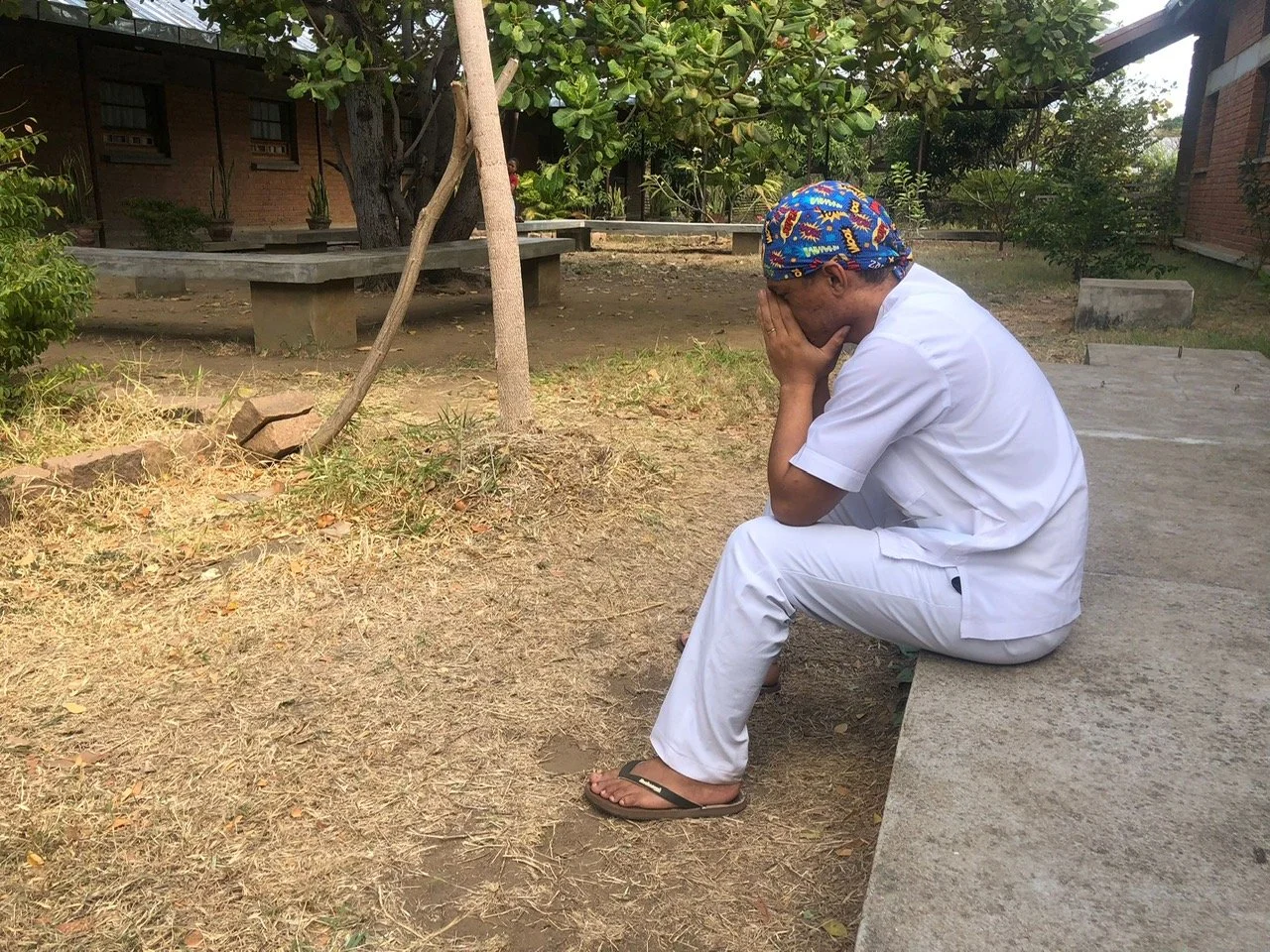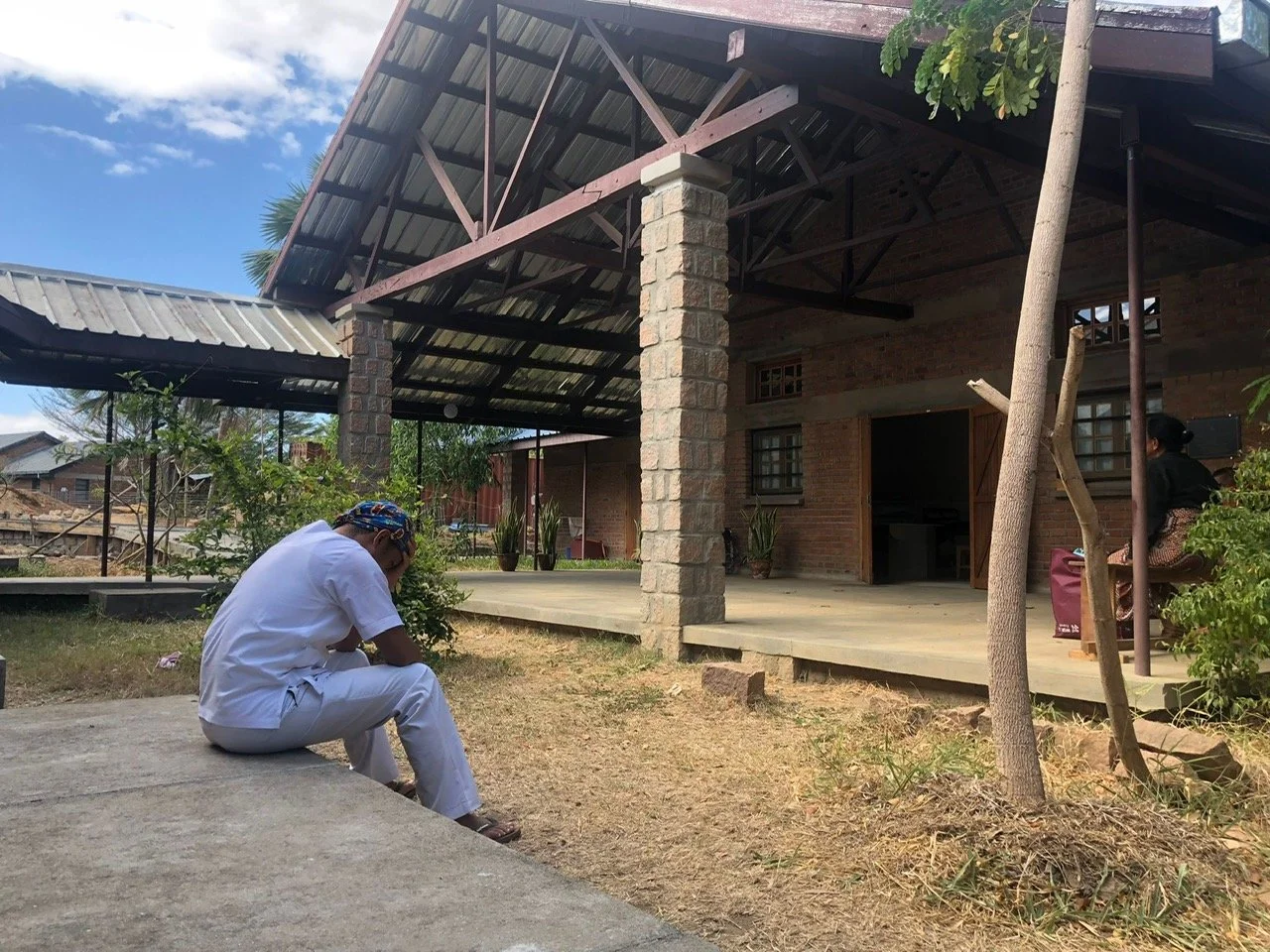Death is an ever-present adversary in Mandritsara. It may seem an odd topic for a story about the hospital, but my hope is that this article will reflect something of the daily reality faced by the team in Mandritsara. If you are a frequent reader of these stories, you may have read many stories about the victories, when horrible circumstances turn out well in the end. This story is not like that. If that’s not for you, please stop reading now. This is a deeply sadstory which is hard to tell, and I imagine might be hard to read. But life for the people of Mandritsara, the local staff,and the missionaries, involves a lot of encounters with death. Tragedy and suffering are part of the human experience across the globe. But for those who trust in Jesus, hope shines in the darkness.
We get the call one afternoon - a young man has arrived vomiting blood. He’s been doing this for a few days, but it has got a lot worse, and now the situation has become critical. Immediately, we mobilise the surgical team. We need to get him to the operating theatre as soon as possible, to find the source of the bleeding, and to stop it. The team acts fast - he’s wheeled in, monitoring is attached, equipment is prepared. The lab is called - we need blood urgently, and lots of it. A message goes out calling anyone with the right blood group to come to the lab now to donate.
Normally, we would start with a gastroscopy - a flexible camera that gives us a view into the oesophagus and stomach. In Mandritsara, the big two causes of bleeding like this are an ulcer, and high pressure veins bleeding because of Schistosomiasis (Bilharzia). But our gastroscope is broken. So we use our colonoscope. It’s twice as long and twice as thick, not the right tool for the job, but it can give us the information we desperately need. Where is the bleeding coming from? The view we get is poor. There is so much blood. But we can see that it’s not the high pressure veins. So logic says we should assume it’s an ulcer.
He has continued to deteriorate. Now his blood pressure is critically low. His life is ebbing away. He’s lost about three quarters of his blood. We make the decision - he needs an operation now to save his life. At top speed we open his abdomen, working carefully but rapidly to expose his duodenum - the most likely place that he would have an ulcer. On opening this first part of the small bowel we find blood - lots of it - but no ulcer. The next place to look is the stomach - you can also get ulcers there. On opening the stomach we find blood once again, but no ulcer. It’s a frustrating feeling. At this point the likely causes get harder to detect. A single aberrant bleeding blood vessel is a possibility, but if it’s not bleeding at the time it can be very hard to spot. By now, the anaesthetic team have stabilised the patient - he’s had blood, his blood pressure has improved, and he seems to have stopped bleeding. This is good news, but it makes finding the problem much harder for us. It’s a well known and depressing scenario for a surgeon. Searching for a source of bleeding in the intestines is often fruitless, especially if it’s not in one of the classic places. We keep looking - putting the scope down into the small bowel, carefully examining the stomach lining, but we can’t find the cause. It’s frustrating. We feel powerless. He’s so young. If we don’t find the cause, he’ll probably bleed again in the coming days, and this time he’ll die. How do you decide to stop looking? How do you decide to close up and admit defeat? We should be able to see where all this blood has come from! But we can’t, and so we stop. Amazingly, he’s alive as we move him back to intensive care, but for how long? Ultimately, the outcome is in the Lord’s hands.
The next day he seems to be doing better. He’s received some blood, he’s awake and talking to us. It’s as good as we could hope for. But soon he begins to deteriorate. His heart is racing at well over twice the normal speed. Is he bleeding again? Does he have sepsis? In the west we’d do a scan. It would guide us towards the best course of action. But here we have to look at the incomplete jigsaw and try to reason out what the picture shows. What is most likely going on? He’s young, he was fit and well before this. Perhaps he will pull through. But as the day progresses things get worse. There’s not much more we can do now.
Life is precious. Life is beautiful. It’s worth the fight. We don’t give up. But we don’t win this time.
He slips away, first becoming unconscious, and then stopping breathing. There’s nothing we can do. Not here in Mandritsara. We have done everything we can and it wasn’t enough. Like sand slipping through our fingers, his life has gone. We tried to grab it, to hold it, to keep it, but we could not.
The family are devastated but stoical. They wrap his body and prepare for the journey home. It’s a deeply sad moment. Not much can ease that sadness. A life of one so young cut so short is a tragedy. But it is not a tragedy with no hope. We have a God who sees our pain, whose heart aches with ours in the face of illness and death. We have a God who is the God of all comfort, who is close to the broken hearted, and draws near with compassion to those who are suffering. Here at the Good News Hospital we have the privilege of being able to talk openly of these things to families who have lost a loved one. We can’t pretend to have all the answers, but we do know that in our deepest pain, our Lord says, “I am near”. We do know that he loves to save those who are crushed in spirit. And so we speak to them of Jesus, the One who has faced death, passed through death, and ultimately defeated death. During his time at the hospital, this young man and his family heard the Good News of Jesus many times. Good news of the One who gave his life to save ours.
Maty ilay tianao Tract
Thank you for reading this story. It represents a realistic scenario that we face in Mandritsara - inspired by patients that we have treated. But for confidentiality reasons it is not the story of one real patient. I hope it gives you a picture of a part of what life is like for those who treat the sick in Mandritsara. We could have written about a child dying from cerebral malaria, or meningitis, or leukaemia. We could have told you about a lady having difficulty in childbirth in her village, arriving with a ruptured uterus, dead baby and sepsis. We frequently face the reality of death. Many times, with the Lord’s help, we are able to give the treatment which saves life. But not always.
When a patient dies and the family takes the body home, we have a tract that we give to the relatives – “Maty ilay tianao” (The one you love is dead). It is based on the Bible account of the death of Lazarus in John 11 and Jesus’s wonderful words on that occasion. It concludes: “This sad day could be the start of new life for you if it brings you to Jesus.”
Please pray:
1. For patients and families in these situations - that they might know God’s comfort, and that He would draw them to Himself.
2. For the tract “The one you love is dead” – that the Lord might touch hearts through it.
3. For the staff as they care for dying patients, that they may be compassionate and caring, pointing each one to the Lord Jesus.
4. For the staff as they face the discouragement and burden of seeing patients die – that the Lord would strengthen and encourage them.




